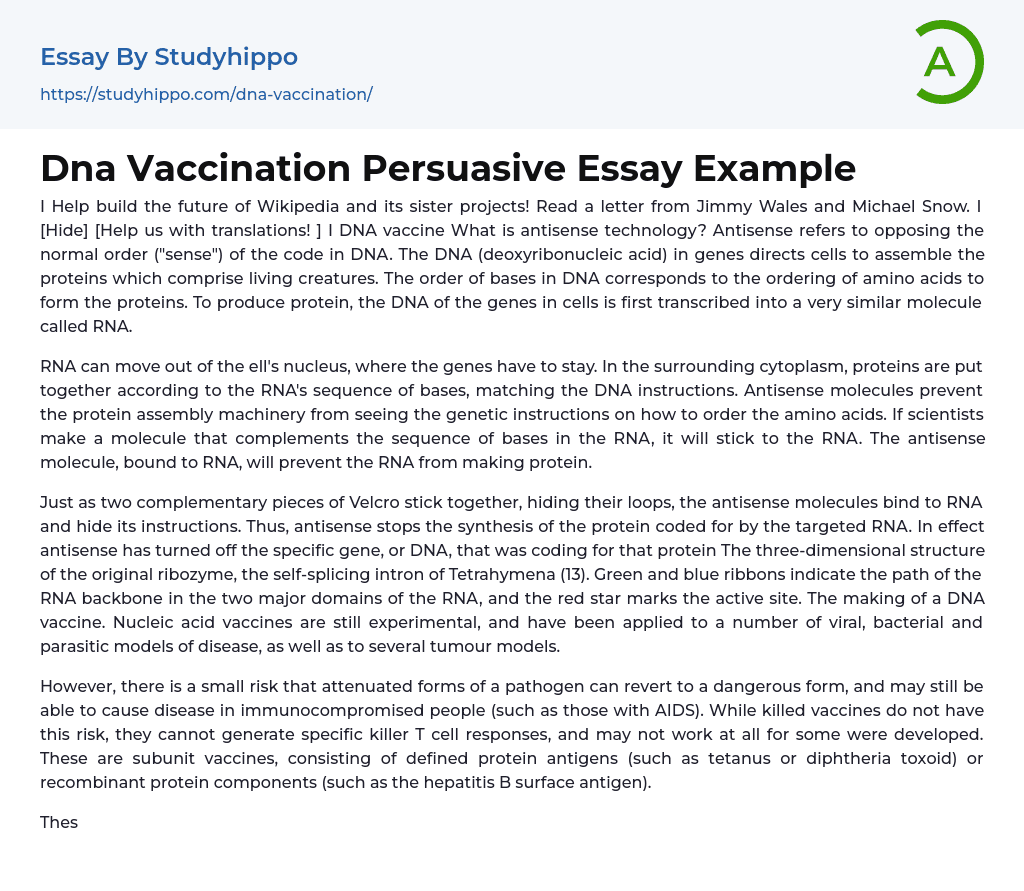I Help build the future of Wikipedia and its sister projects! Read a letter from Jimmy Wales and Michael Snow. I [Hide] [Help us with translations! ] I DNA vaccine What is antisense technology? Antisense refers to opposing the normal order ("sense") of the code in DNA. The DNA (deoxyribonucleic acid) in genes directs cells to assemble the proteins which comprise living creatures. The order of bases in DNA corresponds to the ordering of amino acids to form the proteins. To produce protein, the DNA of the genes in cells is first transcribed into a very similar molecule called RNA.
RNA can move out of the ell's nucleus, where the genes have to stay. In the surrounding cytoplasm, proteins are put together according to the RNA's sequence of bases, matching the DNA instructions. Antisense molecules preve
...nt the protein assembly machinery from seeing the genetic instructions on how to order the amino acids. If scientists make a molecule that complements the sequence of bases in the RNA, it will stick to the RNA. The antisense molecule, bound to RNA, will prevent the RNA from making protein.
Just as two complementary pieces of Velcro stick together, hiding their loops, the antisense molecules bind to RNA and hide its instructions. Thus, antisense stops the synthesis of the protein coded for by the targeted RNA. In effect antisense has turned off the specific gene, or DNA, that was coding for that protein The three-dimensional structure of the original ribozyme, the self-splicing intron of Tetrahymena (13). Green and blue ribbons indicate the path of the RNA backbone in the two major domains of the RNA, and the red star
marks the active site. The making of a DNA vaccine. Nucleic acid vaccines are still experimental, and have been applied to a number of viral, bacterial and parasitic models of disease, as well as to several tumour models.
However, there is a small risk that attenuated forms of a pathogen can revert to a dangerous form, and may still be able to cause disease in immunocompromised people (such as those with AIDS). While killed vaccines do not have this risk, they cannot generate specific killer T cell responses, and may not work at all for some were developed. These are subunit vaccines, consisting of defined protein antigens (such as tetanus or diphtheria toxoid) or recombinant protein components (such as the hepatitis B surface antigen).
These, too, are able to generate TH and antibody responses, but not killer T cell responses. DNA vaccines are third generation vaccines, and are made up of a small, circular piece of bacterial DNA (called a plasmid) that has been genetically engineered to produce one or two specific proteins (antigens) from a micro-organism. The vaccine DNA is injected into the cells of the body, where the "inner machinery" of the host cells "reads" the DNA and onverts it into pathogenic proteins.
of DNA vaccines can ensure the success of the immune response to the encoded antigen, and drive the immune
- Dna essays
- Gene essays
- John Locke essays
- 9/11 essays
- A Good Teacher essays
- A Healthy Diet essays
- A Modest Proposal essays
- A&P essays
- Academic Achievement essays
- Achievement essays
- Achieving goals essays
- Admission essays
- Advantages And Disadvantages Of Internet essays
- Alcoholic drinks essays
- Ammonia essays
- Analytical essays
- Ancient Olympic Games essays
- APA essays
- Arabian Peninsula essays
- Argument essays
- Argumentative essays
- Art essays
- Atlantic Ocean essays
- Auto-ethnography essays
- Autobiography essays
- Ballad essays
- Batman essays
- Binge Eating essays
- Black Power Movement essays
- Blogger essays
- Body Mass Index essays
- Book I Want a Wife essays
- Boycott essays
- Breastfeeding essays
- Bulimia Nervosa essays
- Business essays
- Business Process essays
- Canterbury essays
- Carbonate essays
- Catalina de Erauso essays
- Cause and Effect essays
- Cesar Chavez essays
- Character Analysis essays
- Chemical Compound essays
- Chemical Element essays
- Chemical Substance essays
- Cherokee essays
- Cherry essays
- Childhood Obesity essays
- Chlorine essays




